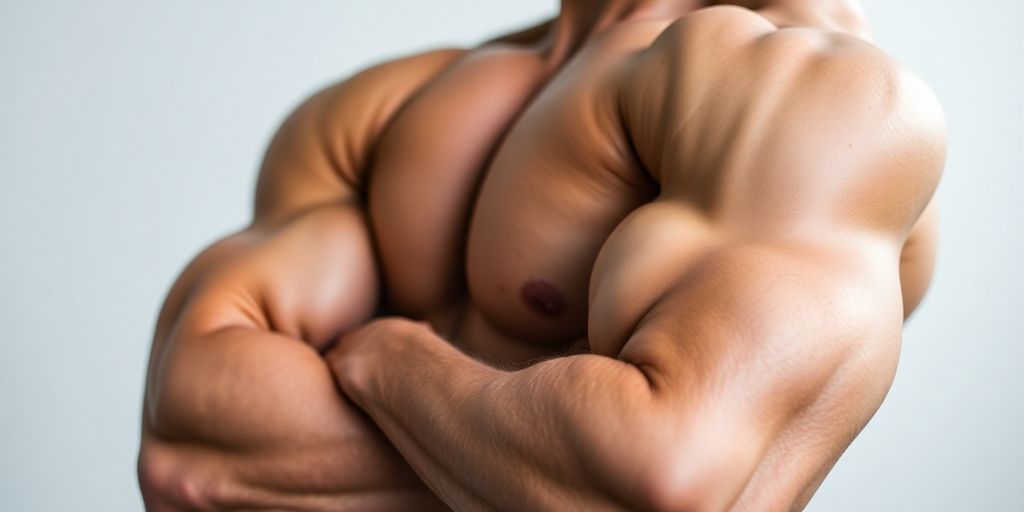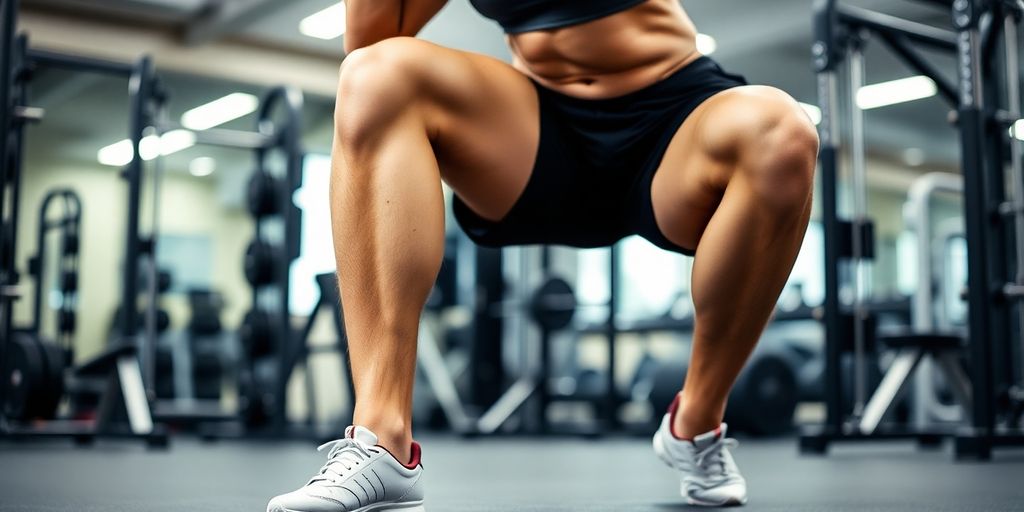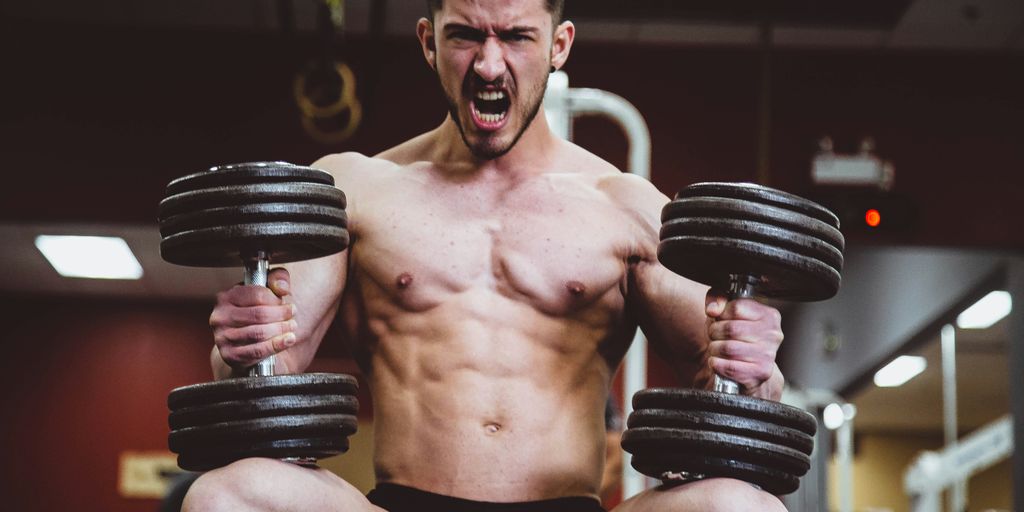Ready to rock those sleeveless tops with confidence? Dive into this ultimate guide on arm workouts focusing on biceps and triceps. Whether you’re a gym-goer or prefer home workouts, this guide has got you covered. From dumbbell curls to tricep dips, we’ve compiled exercises that will help you achieve those toned arms you’ve always wanted. Let’s get started on building strength and definition!
Key Takeaways
- Understanding the anatomy of your arms helps in targeting the right muscles during workouts.
- Incorporate a mix of exercises like barbell bicep curls and tricep dips for balanced arm strength.
- Using dumbbells adds versatility and can enhance both biceps and triceps training.
- Avoid overtraining by scheduling rest days to allow muscle recovery and growth.
- Track your progress and adjust your workout routine to continue improving your arm strength.
Understanding Arm Anatomy for Effective Workouts
Biceps Brachii: Structure and Function
The biceps brachii, often just called the biceps, is a two-headed muscle located on the front of the upper arm. It plays a crucial role in forearm flexion and supination, which is the motion of turning your palm upward. This muscle is not just for show; it’s essential for various daily activities like lifting and carrying. Understanding the structure of the biceps can help you perform exercises that target this muscle more effectively and avoid injuries. When planning your biceps workout, remember to include exercises that challenge both the short and long head of the biceps for balanced development.
Triceps Brachii: Anatomy and Role
On the flip side, the triceps brachii is located at the back of the upper arm and consists of three heads: the long, lateral, and medial. This muscle is primarily responsible for elbow extension, which is the movement that straightens the arm. The triceps are crucial for pushing movements and are often engaged in exercises like push-ups and bench presses. To achieve well-rounded arm strength, it’s important to incorporate a variety of triceps exercises that target all three heads.
The Importance of Mind-Muscle Connection
When it comes to arm workouts, simply lifting weights isn’t enough. Developing a strong mind-muscle connection can significantly enhance your results. This means focusing intensely on the muscle you’re working during each exercise. By doing so, you can ensure that you’re engaging the correct muscles and performing each movement with proper form. This connection helps in effective arm muscle training, ensuring that you’re not just moving weights but actually strengthening and sculpting your arms. A good mind-muscle connection can also prevent injuries by encouraging better form and technique.
Understanding your arm anatomy is like having a roadmap for your workouts. It guides you in selecting the right exercises and performing them correctly, ensuring that each session contributes to your strength and muscle definition goals.
Essential Biceps Exercises for Toned Arms
Mastering the Barbell Bicep Curl
Barbell bicep curls are a classic move for arm workouts. They target the biceps directly and help in building muscle mass effectively. To perform this exercise:
- Stand with your feet shoulder-width apart, holding a barbell with an underhand grip.
- Keep your elbows close to your body and curl the barbell up towards your shoulders.
- Lower the barbell slowly back to the starting position.
- Aim for 3-5 sets of 6-12 reps.
Tip: Keep your back straight and avoid swinging your body to ensure the focus remains on your biceps.
Dumbbell Hammer Curls: Technique and Benefits
Hammer curls are another effective exercise for your biceps, but they also engage the forearms, giving you a more balanced arm workout. Here’s how to do them:
- Stand with your feet flat, holding a dumbbell in each hand with your palms facing each other.
- Curl the weights towards your shoulders while keeping your elbows stationary.
- Lower the dumbbells back to the starting position slowly.
- Perform 3 sets of 8-15 reps.
Hammer curls are great for adding variety to your bicep routine and can help in developing the brachialis muscle, which lies underneath the biceps.
Cable Bicep Curls for Maximum Engagement
Using cables for bicep curls can provide constant tension throughout the movement, which is beneficial for muscle growth. To execute cable bicep curls:
- Attach a straight bar to the low pulley of a cable machine.
- Stand facing the machine, gripping the bar with an underhand grip.
- Keep your elbows tucked in and curl the bar towards your shoulders.
- Lower it back down in a controlled manner.
- Aim for 3-4 sets of 10-15 reps.
Incorporating nine effective upper-body exercises into your routine, including cable bicep curls, can help you achieve well-defined biceps and shoulders.
Top Triceps Workouts for Strength and Definition
Cable Triceps Extensions: Form and Variations
Cable triceps extensions are a fantastic way to target the triceps muscles effectively. The key to maximizing this exercise is proper form. Stand with feet shoulder-width apart, grip the cable handle with both hands, and keep your elbows close to your body as you extend your arms downward. Variations can include using a rope attachment or performing single-arm extensions to target the triceps from different angles.
Bench Dumbbell Triceps Extensions Explained
Bench dumbbell triceps extensions, often called skull crushers, are excellent for building triceps strength. Lie on a bench with a dumbbell in each hand, arms extended above you. Slowly lower the weights towards your forehead, keeping your elbows steady, then push back to the start position. This exercise is great for isolating the triceps and can be modified by adjusting the angle of the bench or using different weight loads.
Triceps Dips: A Bodyweight Challenge
Triceps dips are a challenging bodyweight exercise that can be done almost anywhere. Find a sturdy bench or chair, place your hands on the edge, and extend your legs out in front of you. Lower your body by bending your elbows until they are at a 90-degree angle, then push back up. This exercise not only targets the triceps but also engages the shoulders and core for a full upper-body workout.
When you aim to enhance your triceps, incorporating a mix of exercises like cable triceps extensions, bench dumbbell extensions, and triceps dips can provide a comprehensive workout. Each movement targets the triceps differently, ensuring balanced development and strength gains.
Incorporating Dumbbells for Versatile Arm Workouts
Benefits of Dumbbell Curls for Biceps
Dumbbell curls are a staple for anyone looking to build bicep strength. They allow each arm to work independently, which helps in correcting muscle imbalances. These curls target the biceps brachii and the brachialis, giving your arms a rounded and fuller look. Whether you’re using a hammer grip or a traditional grip, dumbbell curls can be adjusted to focus on different parts of the biceps.
Dumbbell Triceps Kickbacks: Execution Tips
To perform dumbbell triceps kickbacks, start by standing with your feet hip-width apart and knees slightly bent. Bend forward at the waist, keeping your back straight. Hold a dumbbell in each hand, with your elbows bent at a 90-degree angle. Extend your arms back while keeping your elbows close to your body. Squeeze at the top for maximum engagement. This exercise is great for targeting the triceps brachii and can be easily modified by adjusting the weight or repetitions.
Combining Dumbbells with Other Equipment
Incorporating dumbbells with other equipment can amplify your workout. For example, using a bench can help with exercises like the incline dumbbell curl, which targets the upper biceps more intensely. Resistance bands can be added to dumbbell exercises for extra tension, making your muscles work harder. Combining these tools not only diversifies your workout but can also help you break through plateaus.
Dumbbells offer a level of versatility that is unmatched in strength training. With a pair of dumbbells, you can perform a wide range of exercises that target all the major muscle groups in your arms. They are perfect for home workouts and can be easily stored away when not in use.
By incorporating these 20 best dumbbell arm exercises, you can achieve optimal results and sculpt the defined arms you’ve always wanted.
Advanced Techniques for Arm Muscle Growth
Building impressive arm muscles isn’t just about lifting weights; it’s about using the right techniques to maximize every workout. Here’s how you can take your biceps and triceps to the next level.
The 100 Workout: High-Intensity Arm Training
The 100 Workout is an intense routine designed to push your muscles to their limits. It’s all about high-quality repetitions, where the last few reps are the most challenging. The goal is to reach those tough reps quicker, saving energy while still making them count. This workout involves doing 100 reps of an exercise, broken into manageable sets with minimal rest. For instance, you might do 10 sets of 10 reps with short breaks in between. This keeps the muscles engaged and promotes hypertrophy.
Progressive Overload: Key to Muscle Hypertrophy
Progressive overload is the backbone of muscle growth. It’s the practice of gradually increasing the weight, frequency, or intensity of your workouts. Start by adding a little more weight each week or squeezing out an extra rep or two. The idea is to keep challenging your muscles so they adapt and grow. Track your progress and adjust your plan to ensure you’re always pushing your limits.
Balancing Volume and Intensity in Workouts
Finding the sweet spot between workout volume (the total amount of work done) and intensity (how hard you work) is crucial for muscle growth. Too much volume can lead to overtraining, while too little intensity won’t stimulate growth. Aim for a balance by:
- Mixing heavy, low-rep sets with lighter, high-rep sets.
- Ensuring adequate rest between sessions for recovery.
- Listening to your body to avoid burnout.
Remember, the key to effective arm training is consistency and smart planning. Focus on quality over quantity, and your arms will thank you.
Creating a Balanced Arm Workout Routine
Integrating Biceps and Triceps Exercises
Building a balanced arm workout routine means giving equal attention to both the biceps and triceps. Your arms will look more complete and function better when both muscle groups are developed evenly. A well-rounded routine targets each muscle from different angles. For instance, you might start with barbell bicep curls and follow up with tricep dips. This ensures both muscle groups are activated and growing.
Consider this sample routine:
- Barbell Bicep Curls: 3 sets of 8-12 reps
- Tricep Dips: 3 sets of 8-12 reps
- Dumbbell Hammer Curls: 3 sets of 8-12 reps
- Cable Triceps Extensions: 3 sets of 8-12 reps
Scheduling Rest and Recovery for Optimal Gains
Rest is just as important as the workout itself. Your muscles need time to repair and grow stronger. Typically, you should allow at least 48 hours of rest between intense arm sessions. Overtraining can lead to fatigue and injuries, setting back your progress. Aim for 2-3 arm workouts per week, and listen to your body. If you’re feeling overly sore or tired, it might be time to take an extra day off.
Adapting Workouts to Fitness Levels
Everyone’s fitness journey is unique, so it’s crucial to tailor your workouts to your current level. Beginners might start with lighter weights and fewer sets, gradually increasing as they build strength. More advanced lifters can incorporate techniques like supersets or drop sets to challenge their muscles further. Remember, the goal is to push yourself without compromising form. Adjust the number of sets and reps based on how your body responds, and be patient with your progress.
Consistency and patience are key. With dedication, you’ll see your arms transform over time. Keep challenging yourself, and don’t forget to enjoy the journey.
Common Mistakes to Avoid in Arm Workouts
Overtraining: Signs and Solutions
Pushing your arms too hard can lead to overtraining, which might cause fatigue and even injury. It’s tempting to go all out every day, but your muscles need time to recover and grow. Overtraining often shows up as persistent soreness, a drop in performance, or even sleep disturbances. To combat this, make sure to schedule rest days and vary your workout intensity.
Improper Form: How to Correct It
Bad form is a fast track to injuries and poor results. Whether you’re doing bicep curls or tricep dips, maintaining the correct posture is crucial. Keep your back straight, engage your core, and focus on controlled movements. If you’re unsure, consider working with a trainer or recording yourself to spot mistakes.
Neglecting Warm-Ups and Cool-Downs
Skipping warm-ups and cool-downs is a common error that can lead to injuries. A proper warm-up increases blood flow to your muscles, making them more flexible and less prone to tears. Cool-downs help in reducing muscle stiffness and soreness. Simple moves like arm circles or light stretching can make a big difference.
Remember, effective arm workouts aren’t just about lifting heavy weights. They’re about doing it smartly and safely. By avoiding these common pitfalls, you set yourself up for success and stronger, more defined arms.
Tracking Progress and Setting Goals for Arm Workouts
Measuring Strength and Endurance Improvements
Keeping tabs on your arm workout progress is crucial if you’re serious about building strength and muscle. One of the best ways to do this is by tracking your strength and endurance improvements. Consider maintaining a workout journal where you jot down details like the number of reps, sets, and weights used. This way, you can see how much you’ve improved over time.
- Strength Gains: Note the maximum weight you can lift for each bicep and tricep exercise. Gradually increasing this weight is a clear sign of strength improvement.
- Endurance Levels: Track how many reps you can perform before reaching muscle fatigue. More reps at the same weight suggest better endurance.
- Consistency: Regularly record your workouts to spot patterns and areas for improvement.
Setting Realistic and Achievable Goals
When setting goals for your arm workouts, it’s important to be realistic. Start by identifying what you want to achieve, whether it’s increased strength, muscle definition, or overall endurance. Break these goals down into smaller, manageable milestones. For example:
- Short-Term Goals: Aim to increase your bicep curl weight by 5 pounds within a month.
- Mid-Term Goals: Plan to perform 15 tricep dips without resting after three months.
- Long-Term Goals: Work towards completing a balanced routine that includes skull crushers, push-ups, and curls for optimal arm development over six months.
Adjusting Workouts Based on Progress
As you track your progress, you may notice that some exercises become too easy or that you’re not seeing the results you expected. This is the time to adjust your workouts. Consider:
- Increasing Intensity: Add more weight or resistance to your exercises to continue challenging your muscles.
- Varying Exercises: Incorporate different exercises to target your muscles from new angles.
- Listening to Your Body: If you feel fatigued or notice any pain, take a step back and allow for rest or modify your routine to prevent injury.
Remember, progress takes time. Stay patient and committed to your goals. Adjusting your workouts and setting achievable targets will help you maintain motivation and continue seeing improvements.
Wrapping It Up: Your Path to Stronger Arms
Alright, folks, there you have it. Building those biceps and triceps isn’t just about looking good in a tank top—though that’s a nice perk. It’s about gaining strength and confidence, and maybe even surprising yourself with what you can lift. Remember, it’s not about how fast you can get there, but about doing it right. Keep your form in check, push yourself to the edge of your limits, and don’t forget to rest up. Whether you’re a gym regular or just starting out, these workouts can fit into your routine. So grab those weights, stay consistent, and watch your arms transform. You’ve got this!
Frequently Asked Questions
How often should I work out my arms to see results?
For noticeable results, aim to work out your arms 2-3 times a week. Consistency is key, and make sure to allow your muscles time to rest and recover between sessions.
What is the best exercise for building biceps?
Barbell bicep curls are great for building biceps. They target the biceps directly and help increase muscle size and strength.
How can I ensure I’m using the right form during arm exercises?
To maintain proper form, focus on controlled movements and keep your back straight. If unsure, consider consulting a trainer or watching instructional videos for guidance.
Why is it important to include both bicep and tricep exercises in my routine?
Including both bicep and tricep exercises ensures balanced arm development, as these muscles work together for overall arm strength and function.
What should I do if I feel pain while doing arm workouts?
If you feel pain, stop the exercise immediately. Pain can be a sign of injury. Rest and consult with a healthcare professional if the pain persists.
How long does it take to see muscle growth in arms?
Muscle growth can vary, but with regular workouts and proper nutrition, you might start noticing changes in 4-6 weeks.



